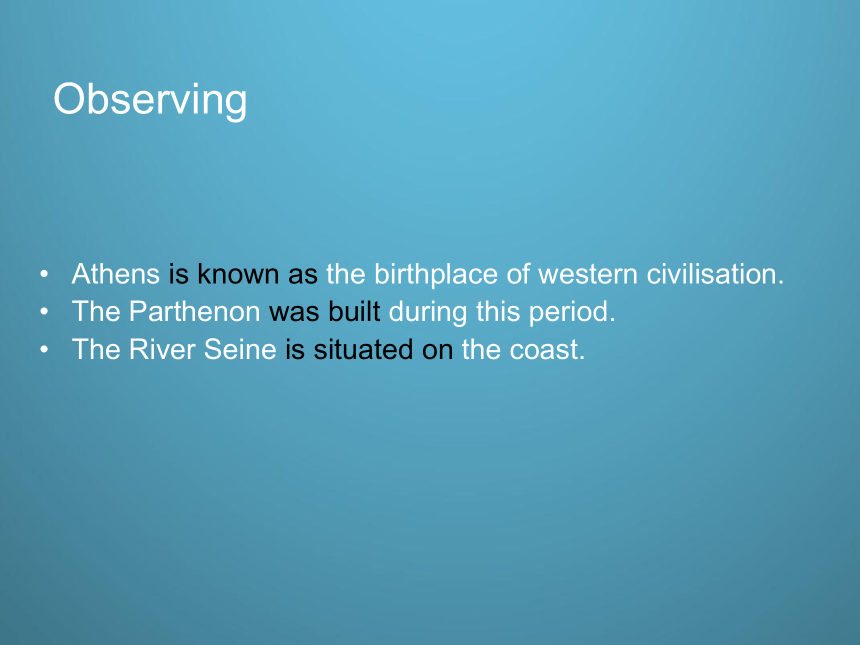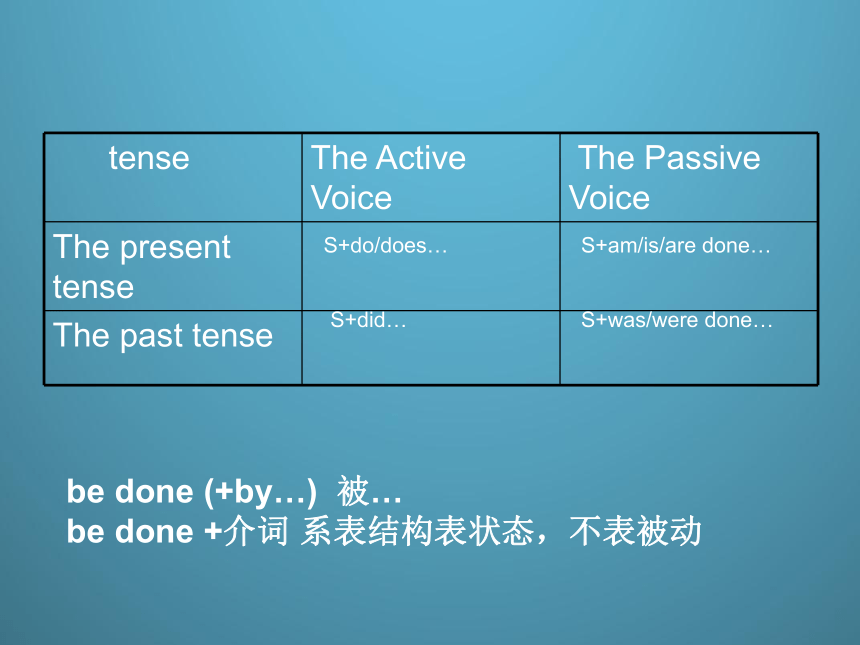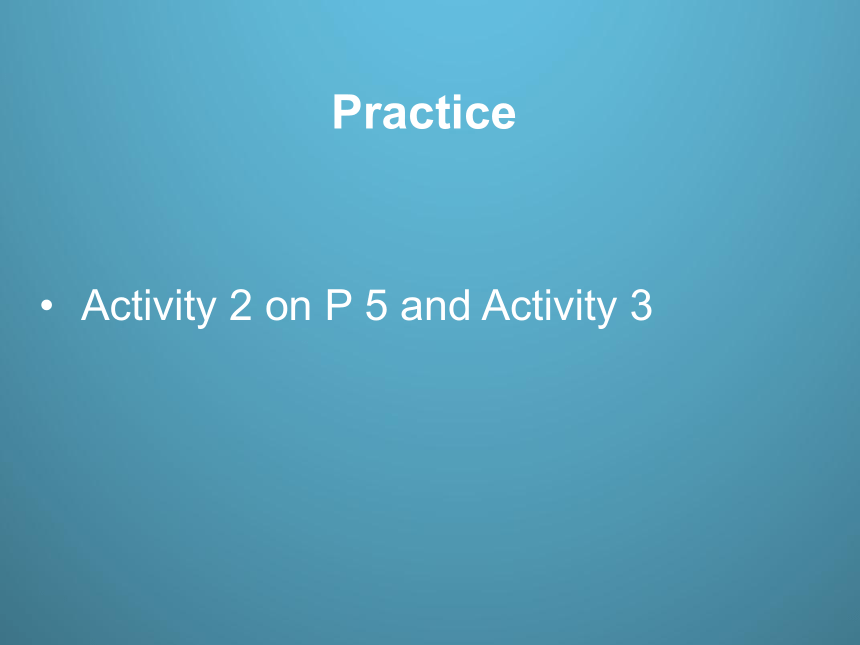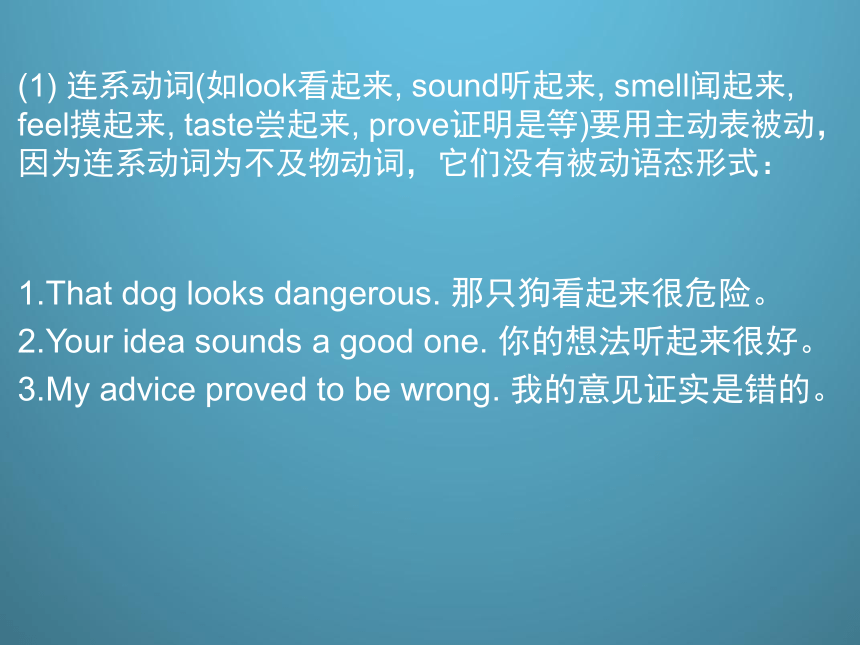外研版必修3 Module 1 Europe Grammar 课件(29张PPT)
文档属性
| 名称 | 外研版必修3 Module 1 Europe Grammar 课件(29张PPT) |  | |
| 格式 | zip | ||
| 文件大小 | 1.4MB | ||
| 资源类型 | 教案 | ||
| 版本资源 | 外研版 | ||
| 科目 | 英语 | ||
| 更新时间 | 2020-05-15 15:32:32 | ||
图片预览









文档简介
(共42张PPT)
Grammar
被动语态和主谓一致
徐翔
1.被动语态
Observing
More than eight million tourists visit Paris every year.
Paris is visited by more than eight million tourists every year.
An architect called Antonio Gaudi designed the Sagrada Familia.
The Sagrada Familia was designed by an architect called Antonio Gaudi.
Observing
Athens is known as the birthplace of western civilisation.
The Parthenon was built during this period.
The River Seine is situated on the coast.
be done (+by…) 被…
be done +介词 系表结构表状态,不表被动
S+do/does…
S+am/is/are done…
S+was/were done…
S+did…
tense The Active Voice The Passive Voice
The present tense
The past tense
Practice
Activity 2 on P 5 and Activity 3
二、谓语动词不可用被动语态的5种情况
1.That dog looks dangerous. 那只狗看起来很危险。
2.Your idea sounds a good one. 你的想法听起来很好。
3.My advice proved to be wrong. 我的意见证实是错的。
(1) 连系动词(如look看起来, sound听起来, smell闻起来, feel摸起来, taste尝起来, prove证明是等)要用主动表被动,因为连系动词为不及物动词,它们没有被动语态形式:
(2) 当open, close, shut, lock, move,等用作不及物动词且表示主语的某种属性时,通常用主动形式表示被动意义:
1.The door won't shut. 这门关不上。
2.The supermarket doors shut automatically. 超市的门是自动关的。
The window won’t shut.
这窗户关不上。(说明主语的属性——窗户有问题了)
The window won’t be shut.
这窗户将不用关上。(窗户本身没问题,只是不用关)
(3) 当read, wash, clean, cook, cut, wear, carry等用作不及物动词通常与well, easily, slowly, quickly等副词连用且表示主语的某种属性时,通常要用主动形式表示被动意义:
The cloth washes well. 这种布料好洗。
The book sells quickly. 这书销售得快。
This cheese doesn’t cut easily. It’s too soft. 这乳酪不容易切,太软了
The sentences read clearly. 这些句子读起来很清楚。(即这句子没有歧义)
The sentences are read clearly. 这些句子被读得很清楚。(指读的人读得好)
(4) 某些表示开始和结束的动词(begin, start, finish, end, last等),当主语为事物且不强调动作的执行者时,可用主动形式表示被动意义:
When does the concert begin? 音乐会什么时候开始?
The play ended at ten o’clock. 戏10点钟结束。
(5) 有的动词本身含有被动意味,通常用主动形式来表示被动含义:
Where is the new film showing? 这部新电影在哪里放映?
My skirt caught on a nail. 我的裙子被钉子钩住了
A picture hangs on the wall.墙上挂着一幅画。
2.主谓一致
主谓一致1.
1.To become doctors is their ambition.
2.Reading is helpful for improving English.
3.What you said is meaningless.
conclusion : 1.不定式、动名词、词组和句子做主
语时,谓语用单数。
主谓一致2.
1. I as well as they am watching the film.
2. Nobody but us is here.
3. The teacher, with his students, is seeing an
English film.
conclusion :2.两个主语由with,together with,along with / as well as / but(除了)/ besides / rather than /including /plus /like(象)/in addition to等来连接时,谓语的数由最前面的主语来确定(就远原则)
主谓一致3.
1. Each boy has an apple.
2. Every minute is important.
3. Nobody knows the facts.
4. Something is wrong.
conclusion 3 :each, every, no, many a, more than one等词修饰主语,或者不定代词 anybody, everyone, something, nothing, no one等作名词时,谓语动词用单数。
注意:多个every/each/no/many a/more than one +单数名词 连接时谓语也要用单数
Every boy and every girl likes to go swimming.
主谓一致4.
1. My family were watching TV at 6 o’clock.
2. My family has moved three times.
conclusion 4.:意义一致指主语形式上是单数,但表达复数意义,那么谓语用复数形式,反之,表达单数意义,谓语动词用单数形式。
主谓一致5.
1. He or I am wrong.
2. Either she or us have to go back.
3. Not only the students but also the teacher takes
part in the games.
4. Neither you or your brother is in fault.
conclusion 5:由or, either…or…, neither…nor…, not only… but also…等连接的并列主语,谓语动词应与最靠近它的主语一致(就近原则)
注意:both...and...要用复数
主谓一致6.
用and连接的并列主语,如果主语是同一个人,(the poet and writer同一事when and where to hold the meeting,同一概念a knife and fork,war and peach, bread and butter谓语动词用单数, 否则用复数.
The poet and writer has come. 那位诗人兼作家来了.(一个人)
A hammer and a saw are useful tools. 锤子和锯都是有用的工具. (两样物)
主谓一致7.
主语中有all, half, most, the rest等, 以及”分数或百分数+名词”,part of , a lot of , lots of , plenty of做主语时,谓语动词单复数取决于连用的名词.
主谓一致8.
表示时间, 金钱, 距离, 度量等的名词做主语时, 尽管是复数形式, 它们做为一个单一的概念时, 其谓语动词用单数.如:
Ten miles is a good distance. 十英里是一个相当的距离。
主谓一致9.
复数的集体名词. 包括police , people, cattle 等, 这些集体名词通常用作复数.
主谓一致10.
the +形容词/过去分词形式”表示一类人或事物, 作主语时, 谓语动词用复数.如:
The injured were saved after the fire.
主谓一致11.
名词如: trousers, scissors, clothes, goods, glasses 等作主语时, 谓语动词必须用复数.
主谓一致12.
“a +名词+and a half “, “one and a half + 名词”, “the number of + 名词” 等作主语时, 谓语动词要用单数
one or two + 复数名词作主语, 谓语动词用复数形式
主谓一致13.
加减乘除用单数.如:
Fifteen minus five is ten . 15减去5等于10
practice
Finish off the exercises of Activity 2,3 and 4 on Page 7
Grammar
被动语态和主谓一致
徐翔
1.被动语态
Observing
More than eight million tourists visit Paris every year.
Paris is visited by more than eight million tourists every year.
An architect called Antonio Gaudi designed the Sagrada Familia.
The Sagrada Familia was designed by an architect called Antonio Gaudi.
Observing
Athens is known as the birthplace of western civilisation.
The Parthenon was built during this period.
The River Seine is situated on the coast.
be done (+by…) 被…
be done +介词 系表结构表状态,不表被动
S+do/does…
S+am/is/are done…
S+was/were done…
S+did…
tense The Active Voice The Passive Voice
The present tense
The past tense
Practice
Activity 2 on P 5 and Activity 3
二、谓语动词不可用被动语态的5种情况
1.That dog looks dangerous. 那只狗看起来很危险。
2.Your idea sounds a good one. 你的想法听起来很好。
3.My advice proved to be wrong. 我的意见证实是错的。
(1) 连系动词(如look看起来, sound听起来, smell闻起来, feel摸起来, taste尝起来, prove证明是等)要用主动表被动,因为连系动词为不及物动词,它们没有被动语态形式:
(2) 当open, close, shut, lock, move,等用作不及物动词且表示主语的某种属性时,通常用主动形式表示被动意义:
1.The door won't shut. 这门关不上。
2.The supermarket doors shut automatically. 超市的门是自动关的。
The window won’t shut.
这窗户关不上。(说明主语的属性——窗户有问题了)
The window won’t be shut.
这窗户将不用关上。(窗户本身没问题,只是不用关)
(3) 当read, wash, clean, cook, cut, wear, carry等用作不及物动词通常与well, easily, slowly, quickly等副词连用且表示主语的某种属性时,通常要用主动形式表示被动意义:
The cloth washes well. 这种布料好洗。
The book sells quickly. 这书销售得快。
This cheese doesn’t cut easily. It’s too soft. 这乳酪不容易切,太软了
The sentences read clearly. 这些句子读起来很清楚。(即这句子没有歧义)
The sentences are read clearly. 这些句子被读得很清楚。(指读的人读得好)
(4) 某些表示开始和结束的动词(begin, start, finish, end, last等),当主语为事物且不强调动作的执行者时,可用主动形式表示被动意义:
When does the concert begin? 音乐会什么时候开始?
The play ended at ten o’clock. 戏10点钟结束。
(5) 有的动词本身含有被动意味,通常用主动形式来表示被动含义:
Where is the new film showing? 这部新电影在哪里放映?
My skirt caught on a nail. 我的裙子被钉子钩住了
A picture hangs on the wall.墙上挂着一幅画。
2.主谓一致
主谓一致1.
1.To become doctors is their ambition.
2.Reading is helpful for improving English.
3.What you said is meaningless.
conclusion : 1.不定式、动名词、词组和句子做主
语时,谓语用单数。
主谓一致2.
1. I as well as they am watching the film.
2. Nobody but us is here.
3. The teacher, with his students, is seeing an
English film.
conclusion :2.两个主语由with,together with,along with / as well as / but(除了)/ besides / rather than /including /plus /like(象)/in addition to等来连接时,谓语的数由最前面的主语来确定(就远原则)
主谓一致3.
1. Each boy has an apple.
2. Every minute is important.
3. Nobody knows the facts.
4. Something is wrong.
conclusion 3 :each, every, no, many a, more than one等词修饰主语,或者不定代词 anybody, everyone, something, nothing, no one等作名词时,谓语动词用单数。
注意:多个every/each/no/many a/more than one +单数名词 连接时谓语也要用单数
Every boy and every girl likes to go swimming.
主谓一致4.
1. My family were watching TV at 6 o’clock.
2. My family has moved three times.
conclusion 4.:意义一致指主语形式上是单数,但表达复数意义,那么谓语用复数形式,反之,表达单数意义,谓语动词用单数形式。
主谓一致5.
1. He or I am wrong.
2. Either she or us have to go back.
3. Not only the students but also the teacher takes
part in the games.
4. Neither you or your brother is in fault.
conclusion 5:由or, either…or…, neither…nor…, not only… but also…等连接的并列主语,谓语动词应与最靠近它的主语一致(就近原则)
注意:both...and...要用复数
主谓一致6.
用and连接的并列主语,如果主语是同一个人,(the poet and writer同一事when and where to hold the meeting,同一概念a knife and fork,war and peach, bread and butter谓语动词用单数, 否则用复数.
The poet and writer has come. 那位诗人兼作家来了.(一个人)
A hammer and a saw are useful tools. 锤子和锯都是有用的工具. (两样物)
主谓一致7.
主语中有all, half, most, the rest等, 以及”分数或百分数+名词”,part of , a lot of , lots of , plenty of做主语时,谓语动词单复数取决于连用的名词.
主谓一致8.
表示时间, 金钱, 距离, 度量等的名词做主语时, 尽管是复数形式, 它们做为一个单一的概念时, 其谓语动词用单数.如:
Ten miles is a good distance. 十英里是一个相当的距离。
主谓一致9.
复数的集体名词. 包括police , people, cattle 等, 这些集体名词通常用作复数.
主谓一致10.
the +形容词/过去分词形式”表示一类人或事物, 作主语时, 谓语动词用复数.如:
The injured were saved after the fire.
主谓一致11.
名词如: trousers, scissors, clothes, goods, glasses 等作主语时, 谓语动词必须用复数.
主谓一致12.
“a +名词+and a half “, “one and a half + 名词”, “the number of + 名词” 等作主语时, 谓语动词要用单数
one or two + 复数名词作主语, 谓语动词用复数形式
主谓一致13.
加减乘除用单数.如:
Fifteen minus five is ten . 15减去5等于10
practice
Finish off the exercises of Activity 2,3 and 4 on Page 7
